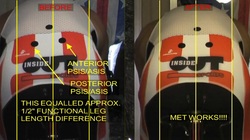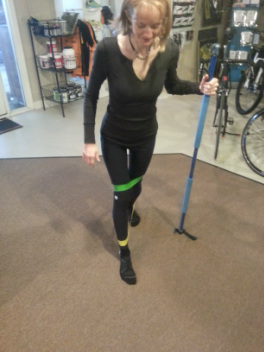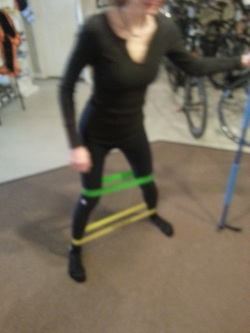 I am sure you have seen this picture on my website and on an earlier blog post. In the earlier blog post I talk about two aspects of the bike fit: mechanical and physical. In this picture the cyclist was riding in a very closed hip angle, his pelvis was in a posterior rotation so his core was not engaged, and he had a significant pelvic inflare. These conditions all influenced how this cyclist sat on his bike... crooked. Like this cyclist, I have many clients say they feel uneven on the bike. So I address many issues... set the bike up to fit the cyclist correctly; demonstrate self treatment muscle energy technique (MET) to realign the pelvis, also assess stability of the foot. Then I look for muscle imbalance, instability, and immobility. Often clients that are uneven on the bike may have a weak core and uneven leg strength. With uneven leg strength there are often times a weak link in the posterior chain and one side of the glute area does not work effectively. There are many exercises that will help glute activation and strengthening: bridges, lunges, etc. One of my favorite exercises is Monster walks (http://www.youtube.com/watch?v=Plp-fEaMvbw). Another great exercise is with bands, too. But you use two bands.  Here I have Cheryl doing a modification of the monster walk by using a light weight resistant band at the ankles and a medium weight band at the knees. This exercise focuses on one leg at a time. I like this modification of the monster walk for athletes just beginning glute activation because they will immediately feel the difference. To begin stand with feet approximately shoulder distance apart with the feet straight. During the exercise the goal is to keep the feet straight to focus on glute activation and to reduce compensation. You may use a wall, etc. for balance if you feel unstable. The knee of the plant/balance leg should have a slight bend. For the action leg I recommend lunging backward and forward at approximately 30 to 45 degrees away from the start point and also lunging to the side. I recommend doing three sets of ten repetitions in the following clock positions: 1. Left leg as action leg and Right leg plant leg: 1 x 10 to the 7 o'clock, then 1 x 10 to the 9 o'clock, then 1 x 10 to the 11 o'clock. 2. Right leg as action leg and left leg as the plant leg: 1 x 10 to the 5 o'clock, then 1 x 10 to the 3 o'clock, then 1 x 10 2 o'clock positiion. Then repeat 2 more sets of 10 on each leg.  As you progress do the exercises without relying on something for balance. Then progress with higher levels of resistant bands. I guarantee you will feel the glutes at work. And who knows you may even wake one side up. You can buy these bands from www.performbetter.com or swing by the lab I always have plenty in stock.
1 Comment
 I am a big fan of using shorter crank arms especially for TTs and triathlon events. In the author's four part article I agree with some of his findings and recommendations. But I also feel that some of his recommendations such as saddle angle is too general (another blog issue later) as well as his two cleat placement study: 1. ball of foot versus 2. mid foot (TMT joint) this is another blog issue for later, . Anyway back to the shorter crank concept. Please read the link and think about the concept: http://www.cycleops.com/en/training/training-resources.html?view=entry&category=training&id=405:fit-part-4 This will be a short and sweet post.
* 93% of the adult population have pelvic malalignment... which causes a functional leg length difference. * 80% of the adult population pronates which typically causes pelvic malalignment... which causes a functional lleg length difference. * nearly 100% bike shops address leg length differences with shims and spacers. Rather than using shims and spacers to address the majority of these "functional" leg length problems I recommend trying muscle energy technique (MET). So, see your local PT or a someone who understands how to correct for pelvic malalignment. Hey, I know a certain bike fitter who can show clients how to do MET:) Here is an interesting link regarding pelvic malalignment: http://www.atlantotec.com/en/disorders/leg-length-discrepancy-tilted-pelvis-pelvic-obliquity A Mr. Garcia from Carolina Trace called me the other day to schedule tune-ups for two bikes. He wanted to know the price and I told him "Rather than setting a fee for categorized services, I prefer seeing the bikes first and then give you a quote. I asked if he was from in town?" Mr. Garcia said "No, I live in Carolina Trace."
I gave Mr. Garcia some options for closer bike shops in his area but he said, "I have already been to these shops and I was not happy with the services and the prices for that matter." I thought, wow he must be desperate (or very demanding) to come all the way here. So we set a time for Mr. Garcia to drop off the bikes. Well when I met Mr. and Mrs. Garcia they seemed like very nice people so my concern of them being overly demanding was not an issue. When I looked at the bikes they seemed to be in very good repair. Just a bit dusty and one bike had a flat tire. I asked if they would like to hang around a bit or go into town to shop, because I felt this was a fairly quick turn around for the bikes. Long story short... I had the bikes finished under an hour. One bike needed a new tube and the front and rear derailleurs adjusted as well as the front brake adjusted. The second bike needed the tubes stems reset to straight and the front brake adjusted and a couple spokes tightened. I had this accomplished before a Law & Order episode was over. Mrs. Garcia called and I said the bikes were ready. When they came to pick up the bikes I gave them the total of $25 and they seemed very pleased. By all means I could have advertised $90 for tune ups by why? If it takes very little time shops would under sell and over deliver, right? We can only hope so. For me to advertise $200 for a pro bike fit and $300 for an elite bike fit somewhat falls into this tune-up paradigm. Or does it? Not often do I charge the entire bill. Only if the client and/or the bike need a great deal of time... such as three to four hours or more. Then I charge the entire bill, since I will most likely have a follow up session or two as well. I rarely encourage clients to have the elite fit with the Retul system because it is rarely necessary. Only if I see huge asymmetries and I need to refer the client to a medical practitioner, PT, etc. will I then use the Retul for very detailed data for baseline and follow ups to determine their progress. I know a lot of bike shops use these bike fitting gadgets and in my opinion they are rarely used correctly. But then again if the client is happy the shops must be doing something right. Right? It would be interesting to hear some people's experiences. If a bike fit costs $300 is it the same for everyone? Someone that takes up to three hours compared to someone that is about an hour. I could not look someone straight in the eyes and say "That will be $300." If a client came in and all they needed was a minor change to the bike:)  Right Side Before and After  Left Side Before and After Ted had excessive hip rocking on his right side, he complained of lower back pain, and shoulder and neck pain. This was due to trying to be aero versus achieving a comfortable, powerful, and efficient position. Ted also had an inflare on his right side that caused him to have a functional leg difference of more than 1/2″. His poor bike fit did not allow him to engage his core and have a stable pelvis. So two major things needed to occur for Ted to overcome the functional leg length problem and discomfort. First, I showed Ted how to realign his pelvis through self treatment MET and then… I changed his bike setup to allow him to be stable on the bike. One aspect to consider when getting a bike fit is the “mechanical aspect” this is the type of bike you are riding, the size, geometry and the mechanical adjustments to the bike. This is the most common aspect of the bike fit process. However, it is just a small part of the bike fit process when it comes to rider comfort, performance, and efficiency.
Another aspect to consider is the rider’s physical abilities in regards to mobility, stability, range of motion, and asymmetries. Below is a picture of a client who was not stable on the bike due to a pelvic malalignment. After an assessment I found his bike was initially set up too aggressive with his aero bars too low (mechanical) and his pelvis was off axis due to a rotational (right forward) and inflare (right side) presentation (asymmetry). Once I made the bike adjustments and demonstrated a basic muscle energy technique (M.E.T.) for him to perform he was more stable on the bike. He was also pain free. This client was getting ready to compete for Ironman Louisville.
The client’s strategy for the bike was to ride at approx. 19 mph at a heart rate of approx. 140 bpm with a fueling strategy of 300 calories per hour. The client’s strategy changed after seeing the results from their metabolic test. What should this client do at IM Lou? |
AuthorOver thirty years experience of making mistakes should count for something:) Archives
December 2015
Categories |



 RSS Feed
RSS Feed
